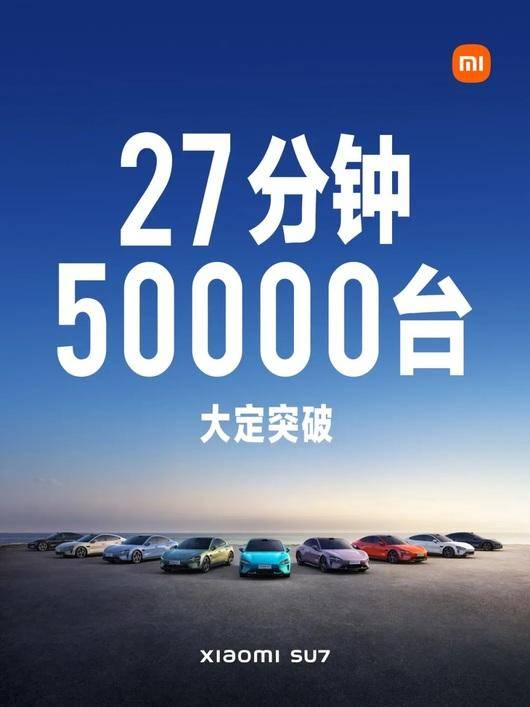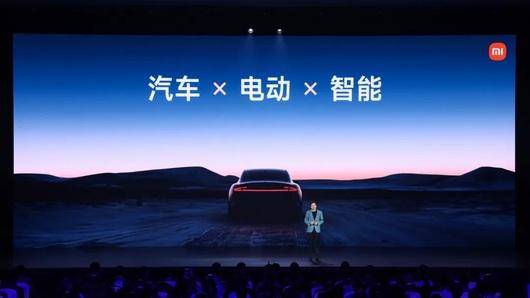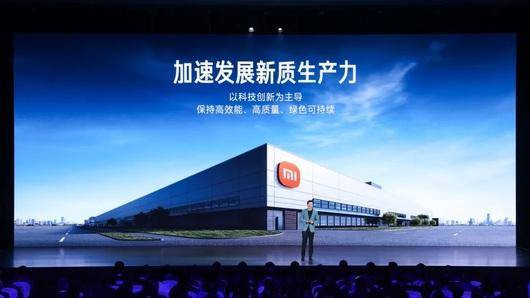Don’t Overrate SU7, Don’t Underrate Xiaomi
There are 3 versions of the car, priced at 215,900 yuan, 245,900 yuan, and 299,900 yuan.
Last night, when Lei Jun revealed the price of the Xiaomi SU7 like squeezing toothpaste, does this situation remind you of the moment when the first-generation Xiaomi phone was announced to enter the market in 2011?
Yes, it seems like it but also not quite.
Different from the past when people observed Xiaomi phones with a spectator’s attitude, this time, the enthusiasm and cheers of the Mi Fans on-site invisibly elevated Xiaomi’s car to a very high starting point. The crowd’s loud approval of the Xiaomi SU7 at the scene exceeded the recognition of any new car released this year, including the haloed Ideal MEGA.

After being on-site, setting aside the fans’ enthusiasm, there was a moment when I was convinced by Lei Jun’s car-making philosophy when I saw Lei Jun introducing the SU7 in the most Xiaomi way while the senior figures in the automotive industry such as Wei Jianjun, Li Bin, Li Xiang, and He Xiaopeng remained silent at the miraculous tactics of the SU7.
But in the midst of all the excitement, are we in the automotive industry still required to calm down and find some crises specific to Xiaomi’s cars, those pitfalls that no one can escape from?
Don’t overrate the SU7 and don’t underestimate Xiaomi. This is a conclusion many in the automotive industry have long drawn. And today, while everything on stage fully embodies Xiaomi’s inherent character, it also correspondingly reflects reality.
The Xiaomi SU7 makes a grand entrance, causing a climax in the tech or Xiaomi fans’ circle, but its overall impact on the automotive industry doesn’t seem as significant. From previous test drives to later explorations, most peers’ evaluation of the Xiaomi SU7 still focuses on it being a versatile model emphasizing value for money, rather than an outstanding work highlighting extreme differentiation.

It can only be said that Xiaomi’s inherent ecological elements truly make it difficult to predict the future of the Xiaomi SU7, so much so that from the end of the launch event until now, it seems like no one can be certain about the direction of “Lei Jun’s car-making” next.
“Car-making is tough, but success is cool”
Lei Jun takes car-making very seriously.
This can be seen from Xiaomi’s actions over the past three years, recruiting extensively from top car companies, investing heavily in building intelligent factories, and various other initiatives. As Xiaomi’s first car-making endeavor, the attention received since the self-exposure of the Xiaomi SU7 also reflects the external expectations for Xiaomi’s cars.
Of course, from shouting the slogan “fight for Xiaomi cars” to now stating that “Xiaomi SU7 is the best-looking, best-performing, and smartest sedan under 500,000 yuan,” Lei Jun is tirelessly promoting the Xiaomi SU7, showcasing a mindset different from all other new forces.
In the past half month, as Lei Jun almost daily posts one or even several Weibo posts, conveying the current situation of Xiaomi SU7 and his sincere dedication to car-making, it is probably a challenge thrown at the current car market. This determination, in my opinion, differs greatly from what founders of new forces like “We Xiaoli” had when announcing their entry.

Newcomers enter the car-making industry only to be thwarted by the market later. I believe that for the always pragmatic Lei Jun, these frequent industry absurdities are undoubtedly being closely watched.
After excluding those early speculators who deceived with PowerPoint presentations, in the past two years, companies like Weimar, Aiways, Skywell, and Gahe, once brimming with aspirations, have either stagnated or even closed down. So, after witnessing these market changes, who can say that Lei Jun’s decision on the price for the Xiaomi SU7 hasn’t been thoroughly considered?
At the event, I heard many loyal Xiaomi fans appreciating Lei Jun’s determination to make cars, and I also saw some traditional media outlets remaining skeptical about tech companies venturing into car production. But from the perspective of Xiaomi cars themselves, I believe Lei Jun’s car-making has achieved a phase of success.
It’s important to note that in this chaotic era, Lei Jun’s own attitude is crucial, but that’s only one aspect of the equation.
Recalling when Lei Jun said, “This is my last major entrepreneurial project; I am well aware of what this decision means. I am willing to stake all my achievements and reputation in life to fight for Xiaomi cars.”

We always think another tech giant is making big claims. When it comes to car-making, even a behemoth like Huawei has been reluctant to wade into these waters. So, Xiaomi, what makes you different?
Now, as the discussion about the Xiaomi SU7 spreads among various circles, even the security guards at the entrance sometimes ask about this car, finally, we understand that apart from Lei Jun’s cautious and all-in attitude towards car-making, the key to whether this new car can lead in the market in the future lies in the word “Xiaomi.” ## Analysis of Xiaomi’s Entry into the Electric Vehicle Market
After observing for the past few months, it seems that there are many who lack trust in tech companies venturing into the automotive industry. Some believe that Xiaomi, known for its focus on cost-effectiveness, is not qualified to compete in the electric vehicle market dominated by traditional car manufacturers. It’s evident that there is a significant number of people who express dislike towards Xiaomi’s SU7 online from various angles.
Despite these sentiments, based on personal experiences, identifying fans within Xiaomi’s extensive user base who are willing to support the SU7 doesn’t seem to be a daunting task.
During the visit to the “Car Community,” there were clear indications of die-hard fans who were willing to pay 350,000 yuan to support the SU7. Additionally, encounters with middle-aged men who traveled from Hunan to Shanghai specifically to see the car were noted. Coupled with the enthusiastic response at the recent launch event, all of these instances shed light on an important perspective.

The question of how many users Xiaomi has arises. Lei Jun mentioned that they have 641 million monthly active global users. Translated to the Chinese market, this number is undoubtedly substantial. Thus, as long as the price of the Xiaomi SU7 is reasonable, there is a high likelihood of an explosive appearance of potential users, which would be rational.
“In 27 minutes, Xiaomi SU7 broke through 50,000 units in pre-orders.” Tonight, Lei Jun can finally sleep soundly.
“Xiaomi” Carries a Heavy Burden
In a post-conference interview, Lei Jun confessed, “This launch has left me both excited and nervous, with a great deal of pressure. We spent so much money, and all the Mi fans, employees, and shareholders are watching our performance. I spoke confidently, treating this debut as a decisive battle… This is the most exhausting release I’ve had so far.”
By positioning the SU7 at a price level lower than that of a Tesla Model 3, considering the existing user base, was Lei Jun perhaps overly concerned at that moment?
I believe not. Lei Jun must be well aware of the limitations of the Xiaomi brand and the high acceptance among Xiaomi users. While the brand “Xiaomi” carries a significant appeal, it doesn’t command the same premium depth as Huawei. Hence, his anxiety and caution are natural expressions given the circumstances.

To illustrate, while the conference was ongoing, there were already people in social circles expressing dissatisfaction with the length of the Xiaomi presentation and even finding the SU7’s integration with other Mi products unbearable. However, excluding the extreme responses of Mi fans at the venue, the attitudes of friends and family outside the car community remained largely positive.
The saying goes, “Xiaomi’s success or failure lies with Xiaomi itself.”
For those who have witnessed Xiaomi’s product quality issues and have a negative view of Xiaomi, this perception remains unchanged. Conversely, individuals who believe in Xiaomi or have grown alongside “Xiao Ai” can somewhat perceive the efforts put into the SU7 by Lei Jun and the supposed advantages of the Mi ecosystem.
Therefore, it is not a given that the Xiaomi SU7 will instantly become a bestseller upon its launch. In comparison to competitors like Xpeng G3 and Tesla Model 3, Lei Jun’s explanations have not convinced the more conservative consumers. There are still criticisms surrounding the Xiaomi SU7, indicating that the initial success of Xiaomi in the automotive industry may need time for the market to validate.
Looking back at Xiaomi’s history in the smartphone era, Xiaomi, a newcomer, shook the dominant smartphone market controlled by global giants like Samsung and Apple by emphasizing value for money, despite initial skepticism from the industry, attesting to Lei Jun’s ambitions.

However, fast forward to today, as a newcomer in the electric vehicle market, Lei Jun and Xiaomi Automotive are determined to make a mark again. Regardless of external support, they need to consider the direction of the market segmentation and also respect the presence of established players like Geely.
Interestingly, right after the launch of the Xiaomi SU7, potential competitors such as the Geely Galaxy E8 and Lixiang C01 quickly responded. This competitive atmosphere invariably affects Xiaomi and reminds Lei Jun that the automotive industry’s competition will be as fierce as, if not more than, the smartphone sector.
Moreover, in 2024, the market is expected to be highly competitive. Xiaomi’s choice to target the challenging 200,000 yuan pure electric sedan market segment implies limited space left for Xiaomi to maneuver.
In terms of data, in the 200,000-300,000 yuan pure electric sedan market segment last year, the combined market share of Tesla Model 3, BYD Han EV, and BMW i3 exceeded 60%. This serves as a reminder to Xiaomi not to be blinded by short-term surprises.
The discussion about Xiaomi’s automotive venture emphasizes the need to wait a while longer before drawing conclusions.

However, even today, seeing the unexpectedly high pre-order numbers for the Xiaomi SU7, it seems that it does not fully capture the essence of Xiaomi’s development. This stems from Xiaomi’s strong brand fragmentation and potentially the lack of unanimous consumer approval of Xiaomi Automotive. ### Overall Reflection on Xiaomi’s SU7 and Hopes for Xiaomi’s Future in the Automotive Industry
As a professional in the field, the outcome of Xiaomi SU7 brought an unprecedented small yet impactful stir to the automotive circle. It remains a truly inspiring event. Given that the success or failure of Lei Jun’s venture into the automotive industry will not be determined solely by the launch of Xiaomi SU7, at this crucial period of industry transformation, there is still hope that Xiaomi’s venture in the automotive sector can become another iconic representation of Chinese automotive excellence on the global stage.
